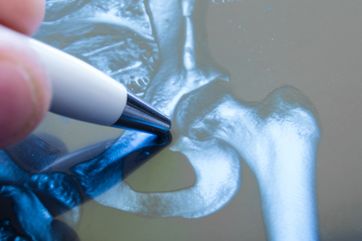Greater hip BMD gains seen with denosumab vs. teriparatide after long-term bisphosphonate use
Long-term bisphosphonate users who switched to the human monoclonal antibody denosumab experienced a gain in hip bone mineral density in the first year of therapy, whereas patients who switched to teriparatide experienced a transient loss in hip BMD, suggesting clinicians should exercise caution when changing osteoporosis agents for patients at high risk for hip fracture, according to a real-world analysis of electronic medical records.

“There is some evidence that prior antiresorptive therapy — in particular, bisphosphonates — may influence the effects of both teriparatide and denosumab,” Houchen Lyu, MD, PhD, a clinical research fellow in the division of rheumatology, immunology and allergy at Brigham and Women’s Hospital in Boston, and colleagues wrote in the study background. “Over 63% of teriparatide users and 54% of denosumab users in the U.S. had been prescribed a prior anti-osteoporosis agent, mostly bisphosphonates. Thus, the therapeutic effect of teriparatide and denosumab in typical clinical practice may not be the same as reported in clinical trials.”
In an observational study, Lyu and colleagues analyzed Partners HealthCare EMR data from 215 patients aged at least 45 years and prescribed bisphosphonate therapy for at least 12 months from 2004 to 2017 (mean age, 70 years; 94% women; median duration of bisphosphonate use, 7 years). All patients subsequently were prescribed teriparatide (n = 110; Forteo, Eli Lilly) or denosumab (n = 105; Prolia, Amgen) for more than 6 months and underwent at least two DXA scans. Primary outcomes were the differences in annualized BMD changes from baseline between the two agents at the lumbar spine, total hip and femoral neck at 2 years.
In weighted analyses, researchers found that denosumab increased BMD at the lumbar spine, total hip and femoral neck, whereas teriparatide only significantly increased BMD at the lumbar spine.

Over 2 years, teriparatide users had a 1.3% greater annualized BMD increase at the spine when compared with denosumab users (95% CI, 0.02-2.7); however, teriparatide users also had a 2.2% greater annualized BMD loss at the total hip (95% CI, –2.9 to –1.5) and a 1.1% greater annualized BMD loss at the femoral neck (95% CI, –2.1 to –0.1).
Additionally, patients who switched from bisphosphonate therapy to teriparatide showed a nonsignificant trend for greater increases in lumbar spine BMD vs. denosumab through the first 2 years, according to researchers. However, teriparatide users also experienced BMD loss at the total hip and femoral neck in the first year, with no overall change over 2 years.
During the consolidation stage, teriparatide users showed continued BMD response at lumbar spine through 36 and 48 months, but responses at the hip areas were lower compared with values observed at the lumbar spine, according to researchers.
“In this particular population, our results suggest the decision of switching to teriparatide should be made with caution, especially for patients at high risk of hip fracture,” the researchers wrote. “Future trials or large observational studies comparing fracture endpoints with special focus on the first 2 years after switching are needed to support our findings.” – by Regina Schaffer
For more information:
Houchen Lyu, MD, PhD, can be reached at Brigham and Women’s Hospital, Division of Rheumatology, Immunology and Allergy, 60 Fenwood Road, Suite 6016, 6th Floor, Boston, MA 02115; email: houchen_lyu@hms.harvard.edu.
Disclosures: Lyu reports no relevant financial disclosures. Please see the study for all other authors’ relevant financial disclosures.
